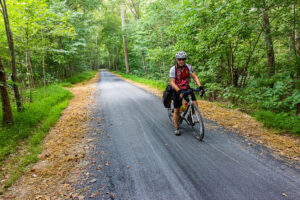Frequently Asked Questions: Towpath Resurfacing Project

The resurfaced towpath near Dargan Bend.
Will the whole towpath be resurfaced?
Following an engineering study done in 2016 with the assistance of the Allegheny Trail Alliance (ATA), the towpath was identified as urgently needing rehabilitation. The Park has plans to resurface the towpath in sections, with priority on areas where conditions of the trail have been most affected by potholes, drainage issues, roots, etc.
Which sections of the towpath have been identified for rehabilitation?
Completed in 2019: Mile 30.8 (Edwards Ferry) to Mile 35.5 (Whites Ferry); Mile 54 (Brunswick Family Campground) to Mile 72.8 (Lock 38/Shepherdstown Bridge) (Completed in 2019)
Completed in 2020: Mile 42.2 (Monocacy Aqueduct) to Mile 54 (Brunswick Family Campground)
Completed in 2021: Mile 22.1 (Violettes Lock) to Mile 30.8 (Edwards Ferry); Mile 35.5 (Whites Ferry) to Mile 39.3 (Lock 26); Mile 16.64 (Lock 21) to Mile 22.9 (Seneca Creek)
Completed in 2021: Mile 72.8 (Lock 38/Shepherdstown Bridge) to Mile 86.9 (Big Slackwater boat ramp)
Completed in 2022: Mile 137.8-140.7 (Western Maryland Rail Trail Towpath Connector)
Current Project: Paw Paw Tunnel (mile 156) to Spring Gap (mile 173)
Summer 2024: Big Pool (mile 112) to Licking Creek (mile 116)
Future Project: Spring Gap (Mile 173) to Cumberland (Mile 184.5)
Future Project: Mile 173 (Spring Gap) to Mile 184.5 (Cumberland)
What will the rehabilitation involve?
- Removal of rocks, tree roots, and other obstacles.
- Removal of grassy median strip.
- Grading of towpath to facilitate water runoff.
- Re-surfacing with the same crushed stone dust on the Great Allegheny Passage (GAP).
What is the benefit of the new crushed stone dust surface?
The gravel over clay surface, which constitutes the current towpath surface, holds water and is prone to muddiness when wet. Crushed stone dust, particularly on a properly graded surface, does not retain water and hardens with use, making it less likely to erode and rut. It is also easier to maintain over time.
How is the work being funded?
Funding for the project comes from a variety of sources, including the National Park Service and grants from the State of Maryland. Grassroots advocacy from canal enthusiasts has helped the C&O Canal National Historical Park secure $6.5 million in funding from Maryland’s Transportation Alternatives Program (TAP) for towpath resurfacing over seven years.
How is the C&O Canal Trust supporting the towpath resurfacing project?
The Trust is raising funds to support engineering consulting and other support services and directly supporting resurfacing. It is also spearheading advocacy for ongoing TAP funding.
What can I do to help?





